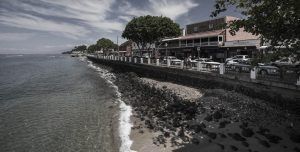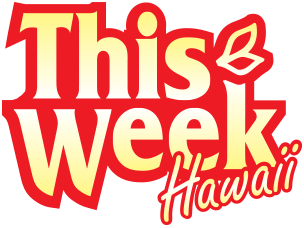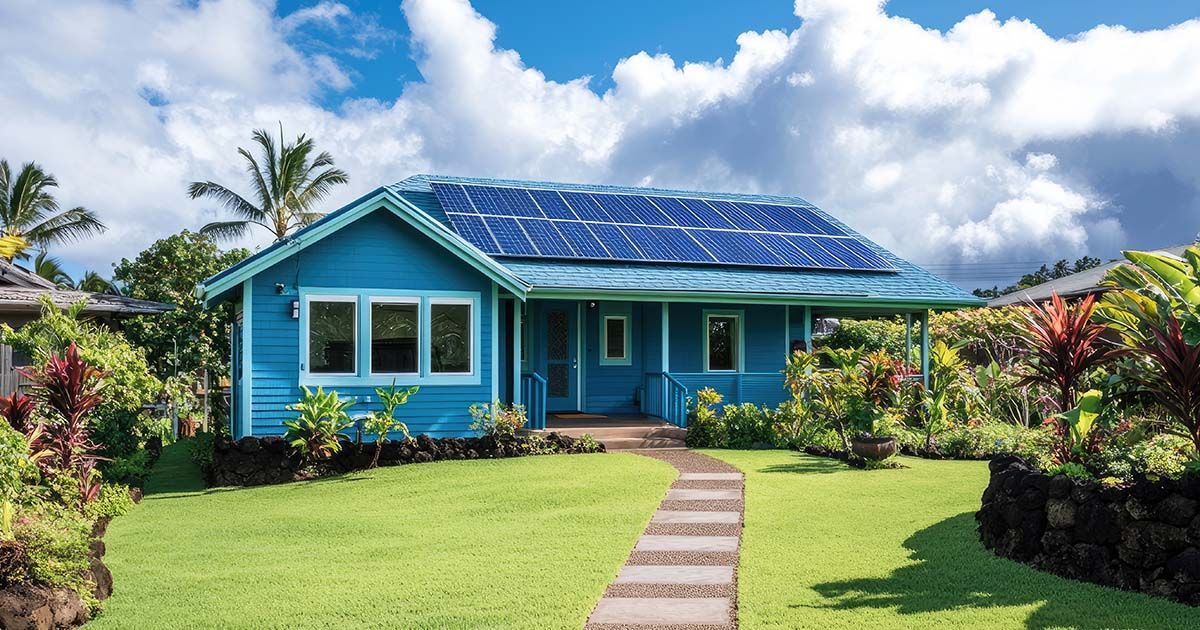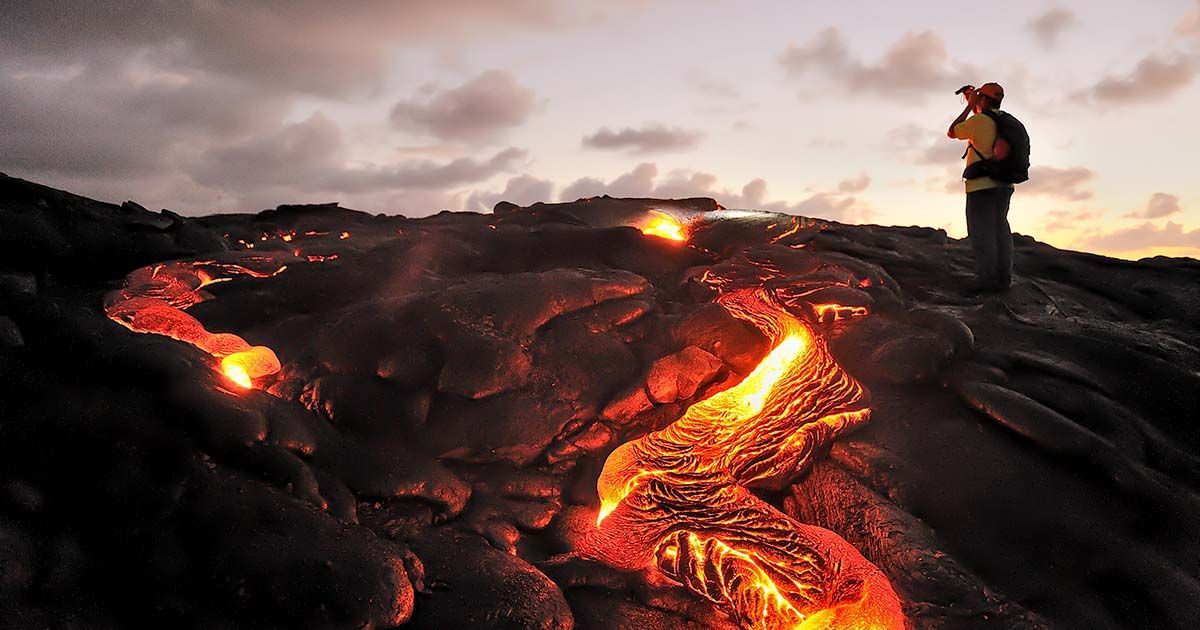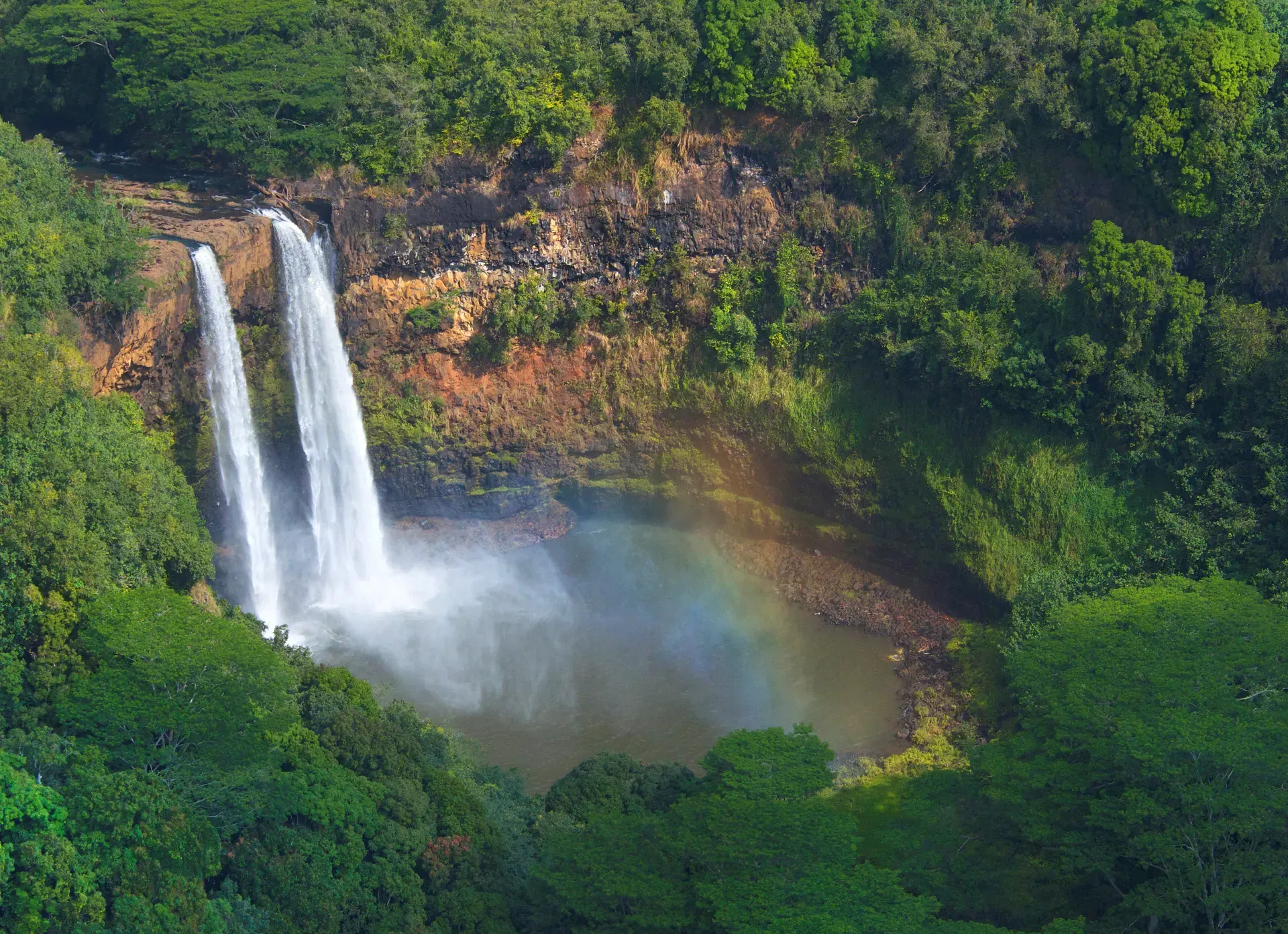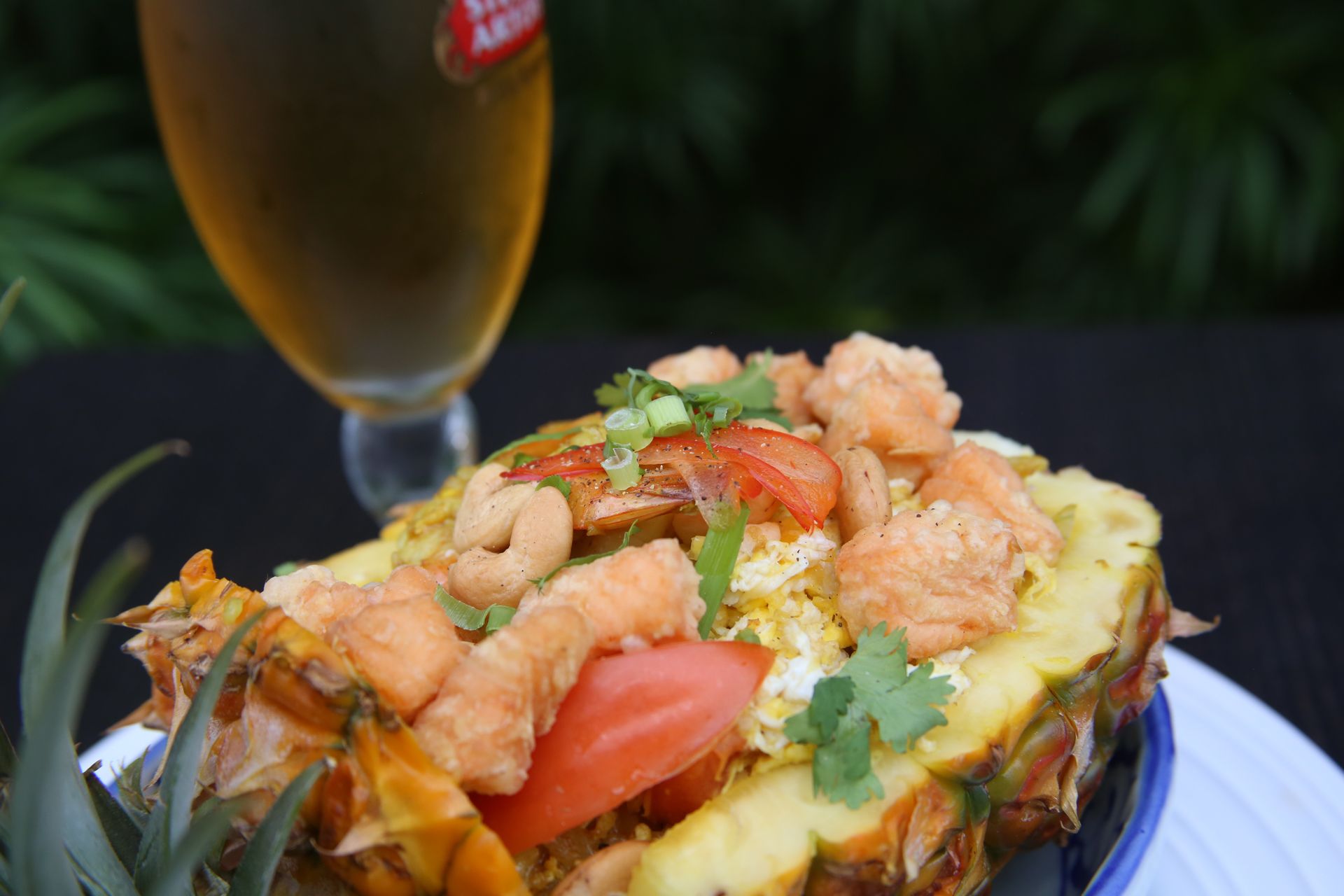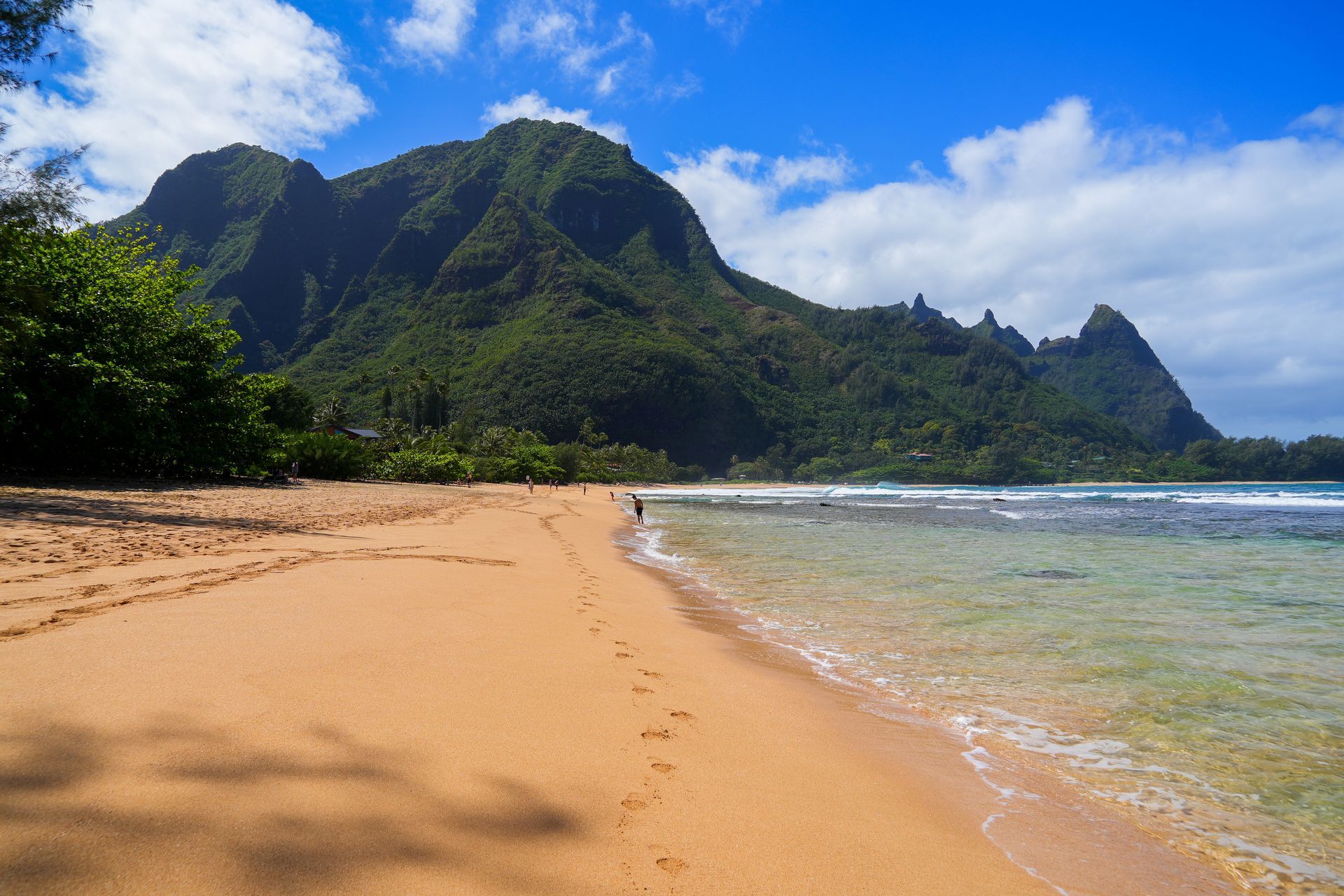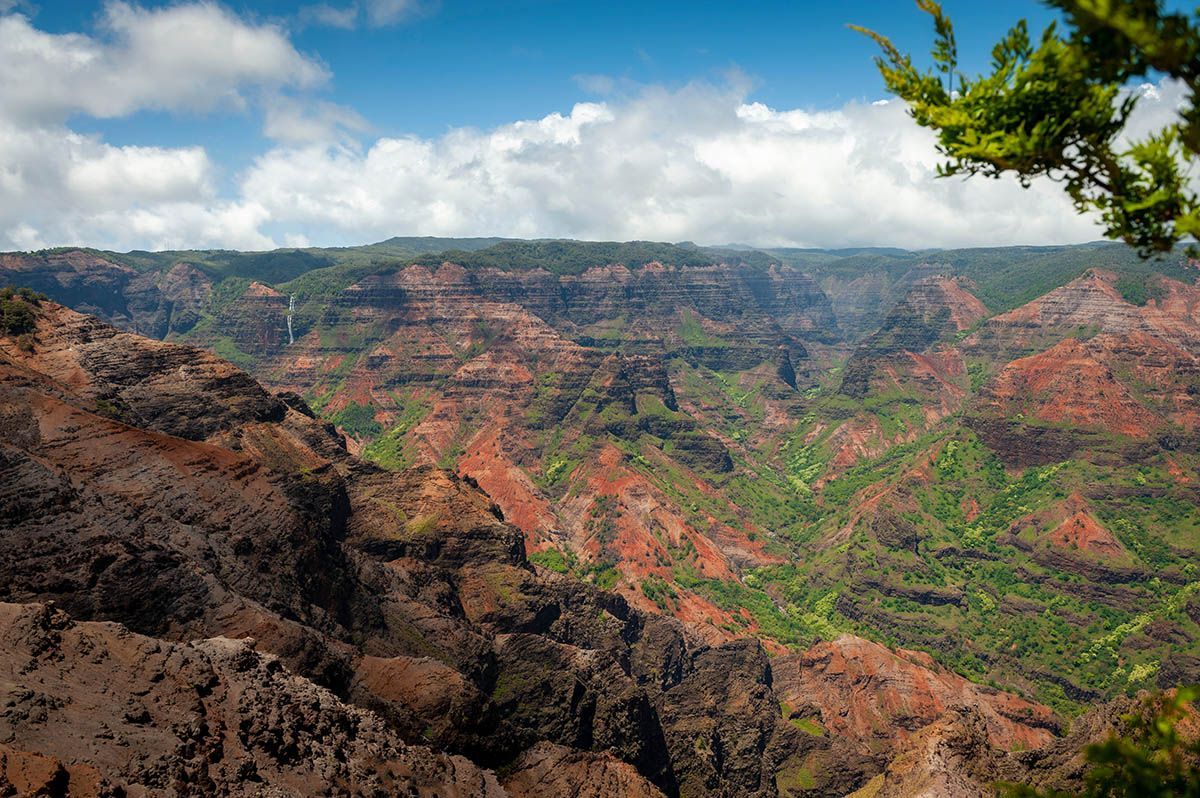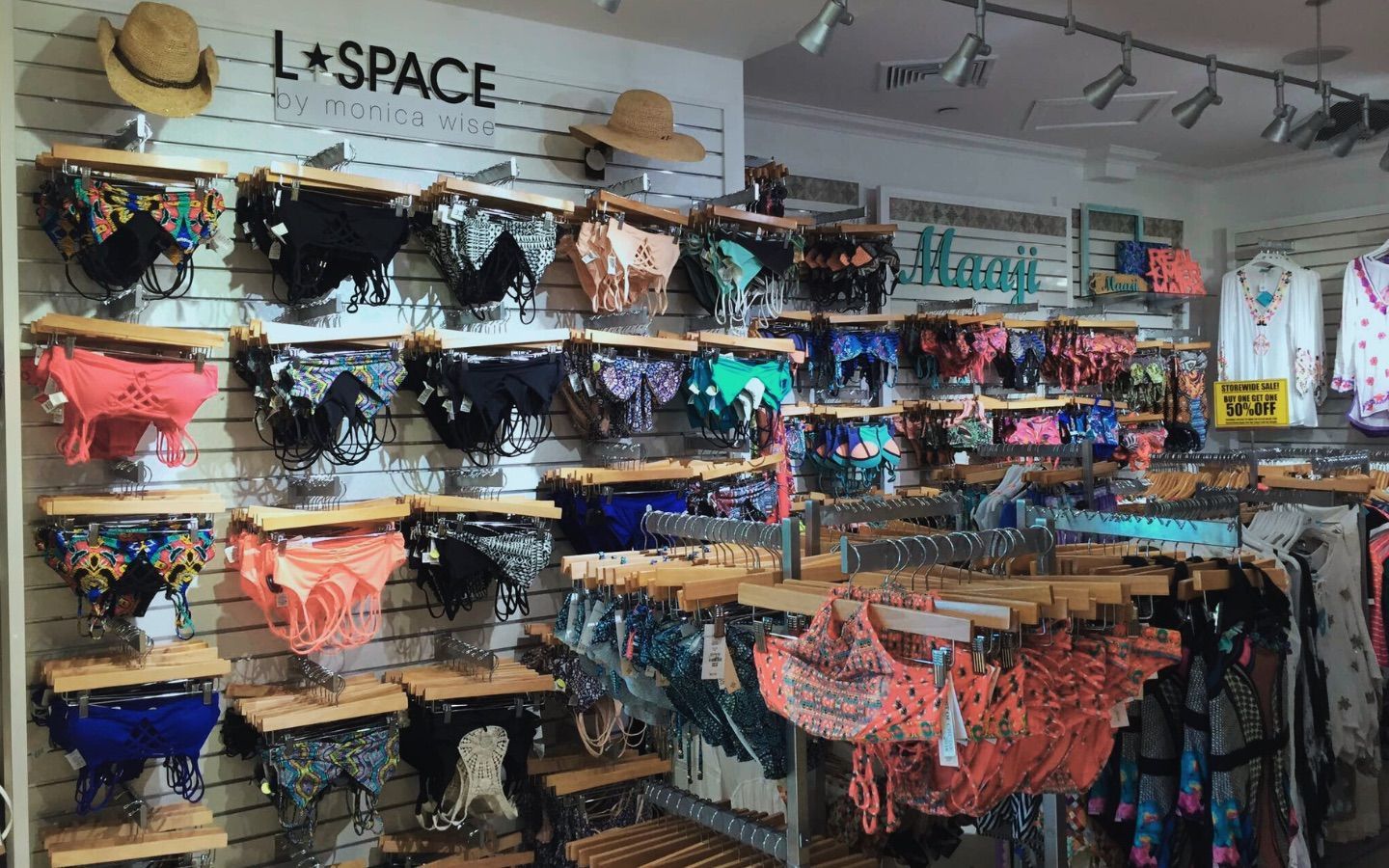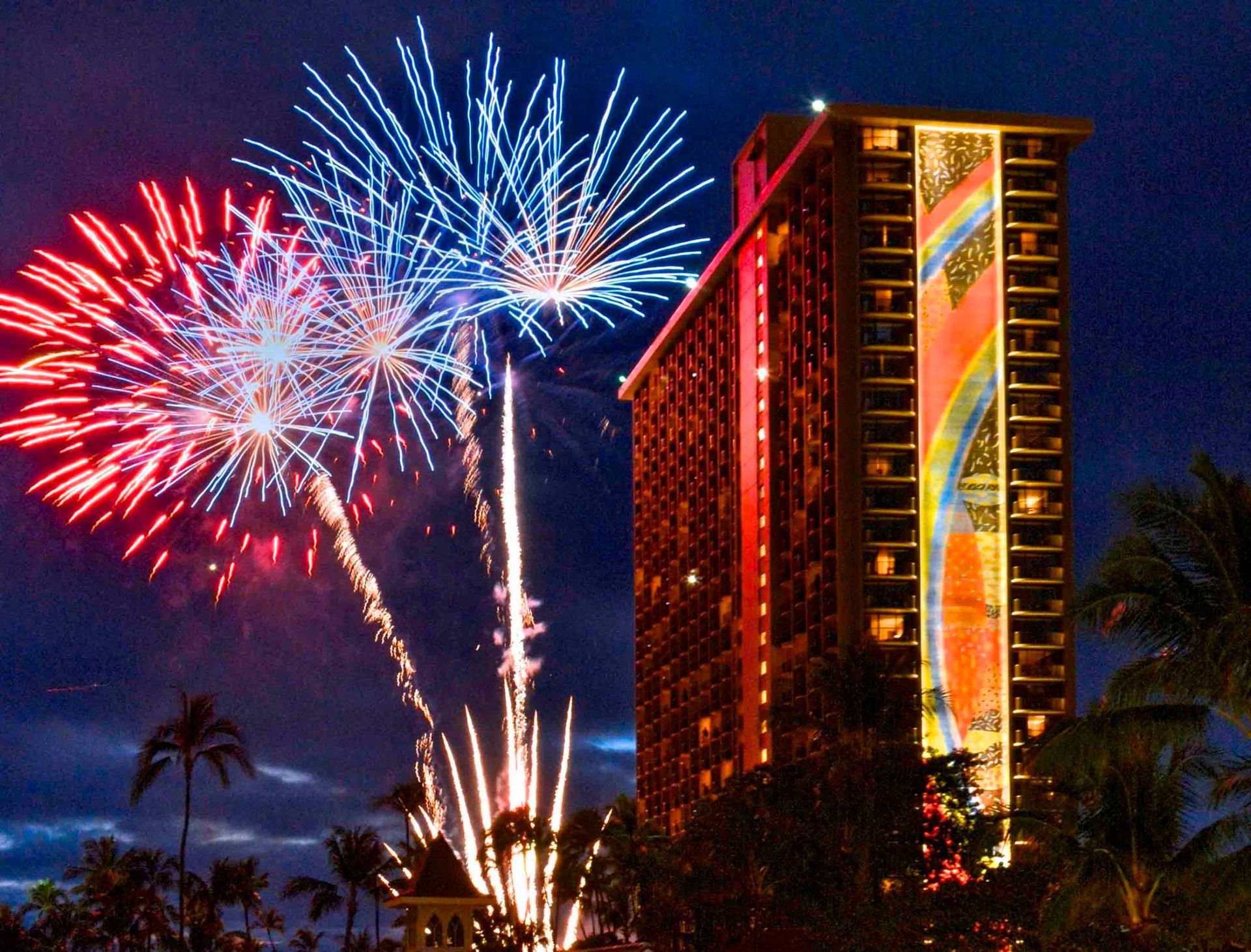Road to Hana Guide: Where to Stop & What to See
Planning your Road to Hana adventure? Discover the best stops, waterfalls, beaches, and hidden gems along this scenic Maui drive
The Road to Hana is one of Hawai'i's most scenic drives, offering stunning waterfalls, lush rainforests, black sand beaches, and breathtaking coastal views. This 64-mile route on Maui is an adventure filled with over 600 curves and 59 bridges, winding through tropical landscapes and offering hidden gems at every turn. Whether you're a first-time visitor or a returning traveler, this guide will help you navigate the best stops and must-see attractions.
Table of Contents:
- What is the Road to Hana
- Best Time to Visit the Road to Hana
- How to Prepare for Your Road Trip to Hana
- Road to Hana Must-See Stops
- Mile Marker 2: Twin Falls
- Mile Marker 10: Garden of Eden Arboretum
- Mile Marker 12: Ke'anae Peninsula
- Mile Marker 17: Wailua Valley Lookout
- Mile Marker 25: Nahiku Marketplace
- Mile Marker 32: Wai'anapanapa State Park
- Mile Marker 34: Hana Town
- What to Pack for the Road to Hana
- Safety Tips & Driving Etiquette
- FAQs
What is the Road to Hana?
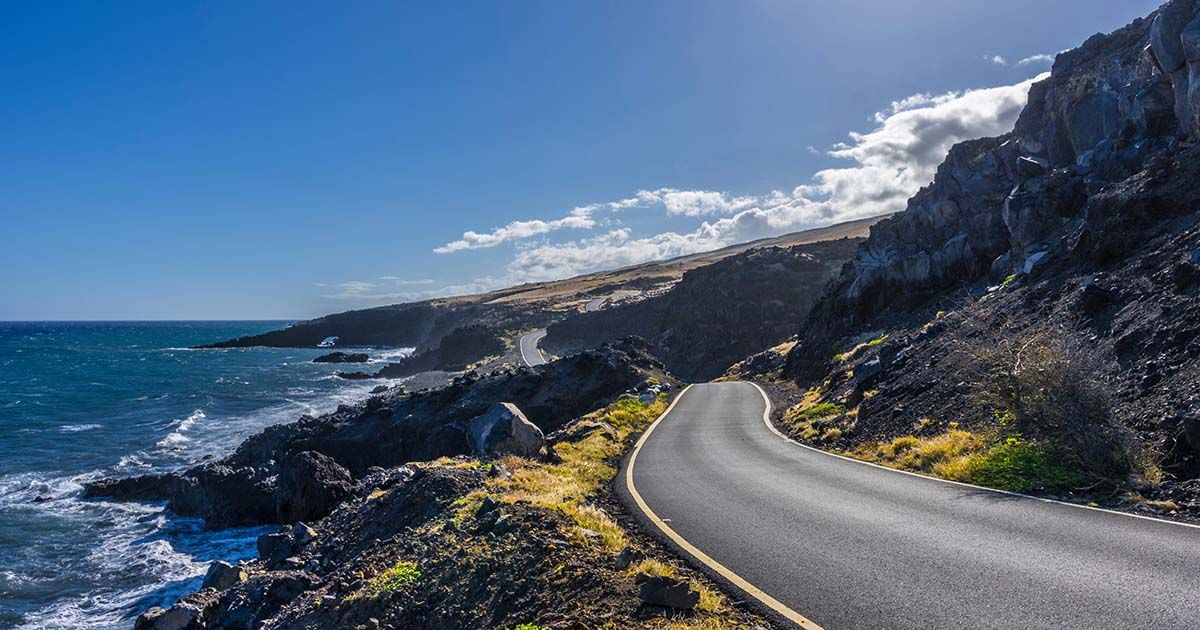
The Hana Highway (HI-360) is a narrow, winding road that connects Kahului to the small town of Hana on Maui's eastern coast. Originally built to support local sugar plantations, the Road has become a bucket-list experience for travelers seeking natural beauty and Hawaiian culture.
- Distance: 64 miles (from Kahului to Hana)
- Estimated Drive Time: 2.5 to 3 hours (without stops)
- Bridges: 59 (most are one-lane)
- Turns: Over 600 curves!
Best Time to Visit the Road to Hana
The Road to Hana is a year-round attraction, offering stunning views and unforgettable experiences no matter when you visit. However, certain seasons, days, and times provide a more enjoyable and less crowded experience. Below, we'll explore the best months, ideal days, and the optimal time to start your journey for a smooth, stress-free adventure.
While you can drive the Road to Hana year-round, some seasons offer a better experience:
Best Months to Visit
While Maui enjoys warm, tropical weather all year, some months are better suited for driving the Road to Hana. The best times to visit are:
- April to June – Spring brings mild temperatures, lush greenery, and fewer tourists than the peak winter season. You'll enjoy comfortable weather with less rainfall than in winter, making it ideal for exploring waterfalls and hiking trails.
- September to November – Fall is another great time to visit, with lower humidity, lighter crowds, and pleasant temperatures. The summer rush has ended, and hurricane season (which peaks in August) is winding down.
Months to Avoid:
- December to March – Winter is Maui's peak tourist season, meaning the Road to Hana can be crowded, with more rental cars and tour buses on the highway. Additionally, rainfall is at its highest, leading to muddy trails and occasional road closures due to landslides. However, this season also means fuller waterfalls, so if you don't mind the crowds, it can still be a rewarding experience.
- July to August – Summer sees higher temperatures, humidity, and increased tourist traffic as families visit during school vacations. The drive can be slower due to heavier congestion, and parking at popular stops fills up quickly.
Best Days to Drive the Road to Hana
The day of the week you choose for your trip can significantly affect your experience:
Weekdays (Monday - Thursday) are the Best:
- There is less traffic from tourists and locals commuting between Hana and central Maui.
- Easier parking at popular stops like Twin Falls, Waiʻānapanapa State Park, and the Seven Sacred Pools.
- A quieter, more peaceful experience at waterfalls, scenic lookouts, and beaches.
Avoid Weekends (Friday - Sunday) if Possible:
- There is more traffic from tourists and locals, especially on Sunday afternoons when residents return home.
- Higher congestion at significant stops makes it harder to find parking.
- Longer wait times at food stands and rest areas.
If you must drive on a weekend, aim to start early to beat the crowds.
Best Time to Start the Drive
Since the Road to Hana is a full-day adventure (8-12 hours round trip), starting at the right time is crucial for making the most of your trip.
- Best Start Time: 6:00 - 7:00 AM
- Fewer vehicles on the Road = smoother drive.
- More time to explore without feeling rushed.
- Better lighting for photography at scenic stops.
- It avoids afternoon rain showers, which are common in Hana.
- Beats the tour vans typically start around 8:00 AM - 9:00 AM.
- If You Start Late (After 9:00 AM):
- Expect heavier traffic and limited parking at popular stops.
- You may run out of time to see all the major attractions.
- Returning after dark (6:30 - 7:30 PM) can be challenging, as the Road is poorly lit and has sharp turns and cliffs.
Weather Considerations
The weather can change rapidly since the Road to Hana passes through rainforests, coastal cliffs, and valleys.
- Morning: This is the best time for waterfalls, as rain from the night before keeps them flowing. Cooler temperatures make hikes more comfortable.
- Afternoon: Warmer and humid, with a higher chance of rain showers.
- Evening: The drive back can be dangerous in the dark due to limited lighting, winding roads, and potential rain or fog.
Tip: Check the Maui weather forecast before heading out, and be prepared for sudden rain showers.
How to Prepare for the Road to Hana
The Road to Hana is an incredible adventure. Still, it's not your average scenic drive—it's a full-day journey that requires proper planning. With winding roads, limited facilities, and unpredictable weather, being well-prepared ensures a safe, comfortable, and enjoyable experience.
Here's everything you need to know to prepare for the drive:
Rent a Small, Reliable Car
While you don't need a four-wheel drive (4WD) or an SUV for the Road to Hana, a compact, reliable vehicle is highly recommended.
- Why a Smaller Car? The narrow roads, sharp turns, and one-lane bridges make maneuvering easier with a smaller car. Large SUVs and Jeeps can be difficult to park at busy stops.
- Avoid Oversized Vehicles – While tour buses and vans travel the route, larger vehicles can be challenging to handle on tight corners and steep inclines.
- Rental Car Restrictions – Some rental companies prohibit driving beyond Hana to the "back road" (Piʻilani Highway) due to its rough terrain. Check your rental agreement before attempting to drive past Hana.
Fill Up on Gas Before You Go
There are no Gas Stations Between Paia and Hana!
- The last reliable gas station is Paia (Minit Stop, 24/7) or Spreckelsville (Shell Station).
- There is one small gas station in Hana, but it's expensive and may run out of fuel.
- To be safe, start with a full tank before heading out.
Pack Snacks, Water & Food
Food stops are limited, and while there are fruit stands and food trucks along the way, having your provisions ensures you won't go hungry.
- Bring Plenty of Water – The humid climate and outdoor activities will dehydrate you. A reusable water bottle is best.
- Pack Non-Perishable Snacks – Energy bars, trail mix, and fruit will keep you fueled between stops.
- Consider a Picnic Lunch – Dining options in Hana are limited and can be pricey, so bringing sandwiches or a pre-packed meal is a great idea.
- Try Local Food Stands – If you want fresh Hawaiian snacks, look for Aunty Sandy's Banana Bread, coconut stands, and roadside fruit stalls along the way.
Necessary: If you bring food, store trash properly and do not leave food in your car to avoid attracting animals.
Wear Sturdy Shoes & Bug Spray
The Road to Hana has outdoor adventures, including hiking trails, waterfalls, and muddy paths. Wearing the right gear will keep you comfortable and safe.
Footwear:
- Hiking shoes or sturdy sandals (like Tevas or Chacos) are best for waterfalls and rugged terrain.
- Avoid flip-flops for hikes; they can be slippery and unsafe on muddy trails.
- Bring water shoes if you plan on wading in waterfalls or tide pools.
Bug Spray:
- Essential for waterfalls and jungle hikes. Mosquitoes are common in the rainforest areas.
- Choose a DEET-free, eco-friendly option to protect Hawaii's delicate ecosystems.
Download Offline Maps
Cell Service is Unreliable along the Road to Hana, so it's crucial to have a backup for navigation.
- Download Google Maps Offline – Save an offline route map before leaving Paia.
- Bring a Paper Map – If your phone dies, having a printed map (available at rental car desks) is a competent backup.
Best Stops on the Road to Hana
Here are the top must-see stops along the way:
Mile Marker 2: Twin Falls
One of the first significant stops along the Road to Hana, Twin Falls is a must-visit destination for waterfall lovers, hikers, and those looking to immerse themselves in Maui's lush rainforest. Located just two miles past Paia, this easily accessible waterfall stop offers a perfect introduction to the natural beauty and adventure that awaits along Hana Highway.
What Makes Twin Falls Special?
Twin Falls is known for its picturesque waterfalls, refreshing swimming pools, and tropical surroundings. Unlike many other waterfalls on the Road to Hana, this stop is on private property—the Wailele Farm, a locally owned and operated agricultural property. Fortunately, the farm owners graciously allow public access. In return, visitors are encouraged to respect the land and support local farm stands.
Twin Falls has multiple waterfalls, with two central cascades easily accessible from the parking lot.
- Lower Falls (First Waterfall) – The closest and easiest waterfall to reach. A short 5-minute walk from the entrance, this small waterfall flows into a shallow pool, making it perfect for families with kids or those who prefer an easy stop.
- Upper Falls (Second Waterfall) – A 15- to 20-minute hike leads to a more enormous, secluded waterfall with a more profound pool ideal for swimming. Many consider this the absolute highlight of Twin Falls.
Along the way, you'll be surrounded by vibrant tropical plants, towering bamboo groves, and lush jungle landscapes that feel like stepping into a Hawaiian paradise.
Twin Falls Farm Stand – A Delicious Pit Stop
The Twin Falls Farm Stand is a must-visit for fresh, locally grown treats. Operated by the Wailele Farm near the farm entrance, the stand sells a variety of Maui-grown fruits, coconut water, banana bread, and fresh smoothies—perfect for refueling before continuing your journey.
Popular Items to Try:
- Fresh-cut pineapple, mango, and papaya
- Coconut candy (a sweet, chewy local favorite!)
- Freshly squeezed sugarcane juice
- Tropical fruit smoothies
- Banana bread – A Maui specialty!
- Buying from the farm stand is a great way to support local agriculture while enjoying authentic Hawaiian flavors.
Best Photo Opportunities
Twin Falls is an excellent spot for photography, thanks to its lush greenery, cascading waterfalls, and serene pools.
Best Photo Spots:
- Lower Falls – Easy to access and great for quick snapshots.
- Upper Falls – More dramatic, with a jungle backdrop perfect for Instagram-worthy shots.
- Bamboo Groves & Rainforest Paths – Capture the magical atmosphere of Maui's tropical forests.
Best Time for Photos:
- Morning Light (8-10 AM) – Softer lighting, fewer crowds.
- Afternoon (12-3 PM) – Sunlight filtering through the trees creates a dreamy effect.
Mile Marker 10: Garden of Eden Arboretum
Recommended Time to Visit: 1 - 1.5 hours
Nestled along the Road to Hana at Mile Marker 10, the Garden of Eden Arboretum is a 26-acre botanical paradise filled with exotic flowers, rare tropical plants, ocean views, and cascading waterfalls. This privately owned and maintained garden was designed to preserve and showcase Hawaii's natural biodiversity, making it a perfect stop for nature lovers, photographers, and anyone looking for a peaceful retreat.
Unlike many stops on the Road to Hana that require hiking, the Garden of Eden is fully accessible by car and foot, with well-maintained walking paths leading to stunning lookouts, rare plants, and a peaceful rainforest atmosphere.
Explore a Lush Tropical Wonderland
The Garden of Eden is home to over 700 labeled plant species, including native Hawaiian flora, exotic tropical trees, and brilliantly colored flowers. As you wander through the well-maintained trails, you'll encounter towering banyan trees, fragrant plumerias, massive rainbow eucalyptus trees, and various tropical fruit trees.
Highlights include:
- Mango, banana, and avocado trees
- Bamboo groves & towering tree ferns
- Native Hawaiian koa trees
- Tropical flowers like heliconias, gingers, and orchids
Fun Fact: Many plants in the arboretum are endangered species worldwide, making this a unique conservation site.
Best Photo Opportunities at the Garden of Eden
The Garden of Eden is one of the most photogenic spots on the Road to Hana, offering a blend of botanical beauty, dramatic landscapes, and stunning ocean views. Here are some of the best photo spots:
- Keopuka Rock ("Jurassic Park View")
- Why It's Special: This famous rock formation was featured in the opening scene of "Jurassic Park" (1993).
- Best Time for Photos: Mid-morning (10-11 AM) for the best natural lighting.
- Photo Tip: Frame the shot with tropical plants in the foreground for a postcard-perfect look.
- Puohokamoa Falls Lookout
- Why It's Special: This 80-foot waterfall is hidden from the highway, making the Garden of Eden one of the only places to see it.
- Best Time for Photos: Morning or after rainfall for a fuller waterfall flow.
- Photo Tip: Use a slower shutter speed to create a dreamy, soft-water effect.
- Rainbow Eucalyptus Trees
- Why It's Special: These multi-colored trees have natural streaks of red, green, blue, and purple on their trunks, creating a stunning rainbow effect.
- Best Time for Photos: Any time of day!
- Photo Tip: Closely capture the tree bark to highlight its surreal colors.
- Tropical Flower Gardens
- Why It's Special: Bright orchids, heliconias, and gingers provide vibrant bursts of color against the lush greenery.
- Best Time for Photos: Morning for soft lighting.
- Photo Tip: Use macro mode to capture intricate details of exotic flowers.
- Ocean Lookout Points
- Why It's Special: The high elevation provides sweeping coastal views of Maui's dramatic cliffs and turquoise waters.
- Best Time for Photos: Late morning to early afternoon for clear skies.
- Photo Tip: Use a wide-angle lens to capture the full landscape.
When to Visit & Insider Tips
- Best Time to Visit: Morning (before 11 AM) – Fewer crowds, cooler temperatures, and better photo lighting.
- Time Needed: Plan for at least 1 hour to explore the main trails and overlooks.
- Bring Cash or Card: There is an entry fee ($20 per adult), but the experience is well worth it.
Mile Marker 12: Ke'anae Peninsula
Recommended Time to Visit: 20-30 minutes
The Ke'anae Peninsula is one of the most dramatic and photogenic stops along the Road to Hana. Unlike other parts of the route dominated by rainforests and waterfalls, Ke'anae offers a breathtaking contrast with its rugged lava rock coastline, crashing waves, and historical Hawaiian taro fields.
This area is steeped in Hawaiian history and culture—it was once home to a thriving Hawaiian village and continues to be a place of deep cultural significance. With jaw-dropping ocean views, a historic stone church, and Maui's most famous banana bread, Ke'anae is a must-stop destination on your journey to Hana.
What to See & Do at the Ke'anae Peninsula
- Marvel at the Rugged Lava Rock Coastline - As you descend the scenic side road off Mile Marker 12, you'll be greeted by a jaw-dropping oceanfront panorama. Ke'anae Peninsula is one of the best places in Maui to witness the raw power of the Pacific Ocean, with massive waves crashing against jagged black lava rocks. Highlights include:
- Spectacular wave action – The strong ocean currents and towering waves make this one of the best places for wave-watching and photography.
- Dramatic lava formations – The coastline is covered in jagged black lava rocks, remnants of an ancient volcanic eruption.
- Salt spray and ocean mist – You can feel the ocean breeze and sometimes even a light mist as waves explode against the rocks.
- Warning: The ocean here is perilous. Swimming is NOT safe due to powerful currents and unpredictable waves. Enjoy the views from a safe distance.
- Visit the Historic Ke'anae Congregational Church (Built in 1856) - One of the most famous landmarks on the Ke'anae Peninsula is the Ke'anae Congregational Church. This beautiful old stone church has stood firm since 1856. Historical Significance:
- It was built by Hawaiian villagers using lava rocks and coral mortar.
- One of the only surviving structures after a deadly tsunami 1946 destroyed most of the village.
- A powerful reminder of the resilience of the local community.
- Photo Tip: Capture a stunning contrast of the church's gray stone walls against the bright green taro fields and deep blue ocean.
- Take in the Scenic Views of the Taro Fields - The Ke'anae Peninsula is famous for its taro farming. This agricultural tradition dates to ancient Hawaiian times. The lush, green taro fields, set against the deep blue Pacific, create a stunning visual contrast unlike anything else on the Road to Hana. What Makes the Taro Fields Special?
- Taro (Kalo) is a sacred crop in Hawaiian culture, used to make poi, a traditional Hawaiian staple.
- The Ke'anae Peninsula is one of the few places on Maui where taro farming is still practiced today.
- The fields provide a peaceful, idyllic setting, perfect for a quiet moment to appreciate Hawaiian history.
- Best Photo Spot: Take a picture of the taro fields in the foreground with the ocean and mountains in the background—a perfect representation of Maui's natural beauty.
- Try the Legendary Banana Bread at Aunty Sandy's. No stop at Ke'anae is complete without tasting Maui's most famous banana bread at Aunty Sandy's Banana Bread Stand. Why It's a Must-Try:
- Made fresh daily, warm, moist, and packed with flavor.
- A local favorite since 1983, it often sells out before the day ends.
- It is best enjoyed with a fresh coconut or a tropical smoothie.
- Photo Tip: Hold up a slice of banana bread with the Ke'anae coastline in the background for the perfect Hawaiian foodie shot.
- Tip: If you plan to stop here, arrive before noon—the banana bread sells fast!
Best Photo Opportunities at Ke'anae Peninsula
Ke'anae Peninsula is a dream location for photographers. Here are the best places to capture the magic of this unique stop:
- The Lava Rock Coastline
- Why It's Special: The contrast between black lava rocks, turquoise waves, and white sea spray creates a dramatic seascape.
- Best Time for Photos: Morning or late afternoon for softer lighting.
- Photo Tip: Use a slow shutter speed to capture the motion of the crashing waves.
- Ke'anae Congregational Church
- Why It's Special: The historic stone church, framed by lush greenery and an ocean backdrop, tells a story of resilience and history.
- Best Time for Photos: Early morning (before crowds arrive).
- Photo Tip: Try an angled shot that captures the church and the ocean for a unique composition.
- The Taro Fields
- Why It's Special: The rich green taro plants, with the ocean and cliffs in the background, make for a beautiful, layered landscape photo.
- Best Time for Photos: Late morning to early afternoon for bright green colors.
- Photo Tip: Use a wide-angle lens to capture the expansiveness of the taro fields.
- Aunty Sandy's Banana Bread Stand
- Why It's Special: A perfect Road to Hana foodie stop, showing authentic Hawaiian flavors.
- Best Time for Photos: Midday, when the banana bread is fresh from the oven.
- Photo Tip: Capture a close-up of the banana bread with the ocean in the background.
Insider Tips for Visiting Ke'anae Peninsula
- Best Time to Visit: Morning for fewer crowds and better lighting.
- How Long to Stay: 20-30 minutes for sightseeing, or longer if you stop for banana bread.
- What to Bring: A camera, reef-safe sunscreen, and cash for Aunty Sandy's.
- Safety Tip: Stay off the lava rocks—the waves are unpredictable and dangerous.
Mile Marker 17: Wailua Valley Lookout
Recommended Time to Visit: 10-15 minutes
The Wailua Valley Lookout is one of the most breathtaking panoramic viewpoints on the Road to Hana. This quick roadside stop offers sweeping views of Wailua Valley, lush rainforests, taro fields, cascading waterfalls, and the distant blue Pacific Ocean.
Wailua Valley Lookout is easy to access, unlike some more hidden gems along the route. It doesn't require hiking, making it a perfect quick stop for incredible scenery and photography.
You'll get a 360-degree view of Maui's eastern coastline and its untouched, jungle-covered valleys from this elevated vantage point. It's a peaceful, scenic spot that offers a glimpse into old Hawaii, where taro farming and traditional Hawaiian practices are preserved.
What to See at Wailua Valley Lookout
- Panoramic Views of the Lush Wailua Valley - One of the best features of this lookout is the breathtaking expanse of Wailua Valley, a lush tropical paradise framed by the towering mountains of East Maui. What You'll See:
- Rolling green taro fields – A nod to Hawaii's traditional farming heritage.
- Steep jungle-covered ridges – Part of Maui's untouched rainforest.
- Towering waterfalls in the distance – Especially visible after heavy rain.
- The glistening Pacific Ocean – A stunning contrast against the deep green valley.
- View of the Historic Wailua Village & Church - Look closely; you'll see the tiny Hawaiian village of Wailua, nestled in the valley below. This small, remote village is one of the few remaining traditional Hawaiian settlements, where generations of families have lived off the land. What Makes It Special:
- The town is home to one of the oldest Hawaiian churches in Maui.
- The community still practices traditional taro farming, continuing a centuries-old Hawaiian tradition.
- Twin Waterfalls Cascading Through the Valley - If you look to the left of the valley, you might spot twin waterfalls flowing down the cliffs—especially after a recent rain. These waterfalls are not visible from the highway, making Wailua Valley Lookout one of the few places to see them. Best Conditions to See the Waterfalls:
- After a rainstorm, when the waterfalls are at their fullest.
- In the morning hours, when the sunlight illuminates the valley.
- The Stairway to the Best Viewpoint - Many visitors miss the best part of Wailua Valley Lookout because they don't realize there's a short stairway leading to an even better view!
- Look for a small set of stairs leading to a higher vantage point in the parking area.
- Climbing just a few steps up offers a less obstructed, wider view of the valley and ocean.
- This higher viewpoint is perfect for photos without guardrails in the way.
Best Photo Opportunities at Wailua Valley Lookout
Wailua Valley Lookout is a dream spot for photographers, offering expansive landscapes, lush greenery, and cascading waterfalls. Here are the best ways to capture its beauty:
- Wide Panoramic Shot of the Valley
- Why It's Special: The layers of mountains, waterfalls, and taro fields create a rich, textured landscape.
- Best Time for Photos: Early morning (soft lighting) or golden hour (warmer tones).
- Photo Tip: Use a wide-angle lens to get the valley, ocean, and sky all in one frame.
- The Ocean Beyond the Valley
- Why It's Special: The lush valley and deep blue ocean contrast sharply.
- Best Time for Photos: Mid-morning to early afternoon (clearer skies).
- Photo Tip: Position a palm tree or wildflowers in the foreground for added depth.
- Twin Waterfalls in the Distance
- Why It's Special: This lookout can only see these hidden waterfalls!
- Best Time for Photos: After rainfall, when the waterfalls are more prominent.
- Photo Tip: Use a zoom lens or phone zoom to focus on the waterfalls without losing clarity.
- The Historic Village & Church
- Why It's Special: A glimpse into old Hawaii, surrounded by jungle and mountains.
- Best Time for Photos: Late morning, when the sun lights up the valley.
- Photo Tip: Use a telephoto lens to zoom in on the church and taro fields for a detailed shot.
- Selfie or Group Shot at the Higher Vantage Point
- Why It's Special: A perfect memory photo with one of Maui's best backdrops.
- Best Time for Photos: Anytime!
- Photo Tip: Stand at the higher viewpoint to avoid guardrails in the frame.
Insider Tips for Visiting Wailua Valley Lookout
- Best Time to Visit: Morning for softer lighting or late afternoon for golden hour
- Time Needed: 10-15 minutes for photos and admiring the view.
- What to Bring: A camera, sunglasses, and a phone for panoramic shots.
- Don't Forget: Climb the stairs for a better view of the valley and coastline!
Mile Marker 19: Upper Waikani Falls (Three Bears Falls)
Recommended Time to Visit: 10-30 minutes
Also known as Three Bears Falls, Upper Waikani Falls is one of the most stunning and iconic waterfalls along the Road to Hana. It features three parallel waterfalls cascading down a lush, jungle-covered cliff, resembling a family of bears—hence the nickname "Three Bears."
What Makes This Waterfall Special?
- Three distinct waterfalls side by side – creating a perfectly symmetrical and photogenic cascade.
- Lush tropical surroundings – framed by vibrant green foliage and moss-covered rocks.
- Easy roadside view – no hiking required for a great photo opportunity.
- A short but rewarding adventure – If you're up for some exploring, you can access the falls from a hidden path below the bridge.
Unlike some other waterfalls on the Road to Hana that require a long hike, Upper Waikani Falls is visible directly from the Road, making it one of the most easily accessible and breathtaking waterfalls on Maui.
Best Photo Opportunities at Upper Waikani Falls
Upper Waikani Falls is one of the most photogenic waterfalls on the Road to Hana, offering multiple excellent photo vantage points.
- The Classic "Three Bears" Shot from the Bridge
- Why It's Special: The three parallel waterfalls create a perfectly balanced, postcard-worthy image.
- Best Time for Photos: Morning or late afternoon for soft lighting.
- Photo Tip: Use a wide-angle lens or panoramic mode to capture all three waterfalls in one frame.
- The Waterfall Base (For Adventurers!)
- Why It's Special: Capturing the falls from below offers a unique, up-close perspective.
- Best Time for Photos: Midday, when the sun illuminates the water.
- Photo Tip: Use a slow shutter speed to create a silky, smooth effect on the falling water.
- Side Angle from the Pull-Off Parking Area
- Why It's Special: Capturing the falls at an angle adds depth to the composition.
- Best Time for Photos: Anytime!
- Photo Tip: Frame the waterfall with overhanging jungle leaves for a natural border.
- Selfie with the Falls in the Background
- Why It's Special: A perfect memory photo to document your Road to Hana adventure.
- Best Time for Photos: Late morning or early afternoon.
- Photo Tip: Stand on the bridge safely to get a full view of the falls behind you.
- Rainforest Close-Ups
- Why It's Special: The area around the falls is lush tropical vegetation.
- Best Time for Photos: The leaves glisten with water droplets after a light rain.
- Photo Tip: Use macro mode to capture detailed shots of moss-covered rocks and tropical plants.
Insider Tips for Visiting Upper Waikani Falls
- Best Time to Visit: Early morning for fewer crowds and softer lighting.
- Time Needed: 10-30 minutes, depending on whether you hike down.
- What to Bring: Camera, waterproof shoes, swimsuit (if swimming), and caution if climbing down.
- Safety First: Watch for flash floods—water levels can rise quickly after rain.
Mile Marker 25: Nahiku Marketplace
Recommended Time to Visit: 20-45 minutes
Located near Mile Marker 25 along the Road to Hana, Nahiku Marketplace is a vibrant roadside stop filled with delicious local food, unique souvenirs, and a laid-back island vibe. It's the perfect place to take a break, stretch your legs, grab a bite to eat, and experience authentic Hawaiian flavors.
Unlike some of the more remote stops along the Road to Hana, Nahiku Marketplace offers a small but lively collection of local vendors, making it a must-visit destination for food lovers and travelers looking to experience Maui's local culture.
What to See & Do at Nahiku Marketplace
- Enjoy Fresh, Locally Made Hawaiian Food - One of the biggest highlights of Nahiku Marketplace is the variety of fresh, locally prepared food, perfect for refueling before continuing the journey to Hana. Best Local Eats to Try:
- Coconut Glen's Ice Cream – A famous vegan ice cream made with organic coconuts from Maui. Try the classic coconut, chocolate, or exotic lilikoi (passion fruit) flavors!
- Island Fish Tacos – Freshly caught mahi-mahi or ono, served with local slaw and a creamy Hawaiian sauce.
- Kalua Pork & BBQ Plates – Slow-cooked Hawaiian-style kalua pork or grilled BBQ chicken served with steamed rice and mac salad.
- Banana Bread – Maui's famous fresh banana bread is made daily with locally grown bananas.
- Fresh Coconut Water – Straight from the coconut! Some vendors will even chop one open for you on the spot.
- Shop for Unique Hawaiian Souvenirs - Nahiku Marketplace is one of the best places along the Road to Hana to find handmade, locally crafted souvenirs. Unlike touristy gift shops in Lahaina or Kihei, the vendors here sell one-of-a-kind, authentic Hawaiian crafts. Best Souvenirs to Buy:
- Handmade Jewelry – Locally crafted shell necklaces, koa wood bracelets, and pearl earrings.
- Hand-Carved Wooden Bowls & Utensils – Made from beautiful koa wood, unique to Hawaii.
- Local Spices & Seasonings – Perfect for bringing the flavors of Maui back home.
- Hawaiian Art & Photography – Featuring stunning Maui landscapes and Hawaiian culture.
- Tropical Fruit & Homemade Jams – Try exotic lilikoi (passion fruit) jam or Maui pineapple preserves.
- Take a Quick Detour to Nahiku Road for Stunning Ocean Views - While Nahiku Marketplace is the main attraction, the scenic Nahiku Road nearby offers one of the most breathtaking ocean views on the Road to Hana.
- Drive down Nahiku Road (off Hana Highway at Mile Marker 25) for about 5 minutes to reach a hidden coastal overlook.
- Along the way, you'll pass lush rainforests, bamboo groves, and beautiful old plantation homes.
- The Road ends near a dramatic oceanfront cliff, offering sweeping views of the Pacific and crashing waves against lava rocks.
- Note: Nahiku Road is narrow and winding, so drive carefully. Do not trespass on private property near the end of the Road.
- Soak in the Lush Rainforest Atmosphere - Nahiku Marketplace is surrounded by towering trees, hanging vines, and tropical plants, creating a magical, jungle-like setting. The incredible, shaded atmosphere makes it a relaxing place to enjoy a meal and Maui's natural beauty. What You'll See:
- Towering banyan trees with twisting roots.
- Bright red and pink ginger flowers lining the pathways.
- Thick, green jungle vines drape from the trees.
- Colorful birds, including red-crested cardinals and mynah birds.
Best Photo Opportunities at Nahiku Marketplace
- Colorful Marketplace Stalls – Capture the vibrant energy of the marketplace with colorful fruit stands, handmade crafts, and tropical flowers in the background.
- Coconut Glen's Ice Cream – A shot of you holding a scoop of coconut ice cream, with the lush rainforest in the background, makes for a perfect food & travel photo.
- Nahiku Road Ocean View – Drive 5 minutes down Nahiku Road to get an epic coastal shot of waves crashing against the cliffs.
- Banana Bread Close-Up – Nothing says "Road to Hana" like a fresh slice of banana bread in hand, with tropical greenery behind you.
- Rainforest Canopy Shot – Stand beneath a massive banyan tree, aim your camera upward and capture the sunlight streaming through the canopy.
Insider Tips for Visiting Nahiku Marketplace
- Best Time to Visit: Mid-morning (around 10-11 AM) to avoid the lunch rush.
- Time Needed: 20-45 minutes, depending on if you stop to eat or shop.
- What to Bring: Cash or a credit card (some vendors are cash-only).
- Try the Banana Bread & Fresh Coconut! These are local favorites you won't want to miss.
- Explore Nearby Nahiku Road for a hidden ocean viewpoint just minutes away.
Mile Marker 32: Waiʻānapanapa State Park (Black Sand Beach)
Recommended Time to Visit: 1-2 hours
Waiʻānapanapa State Park is one of Maui's most breathtaking and unique coastal destinations. Famous for its black sand beach, lava caves, sea arches, and dramatic ocean views, this stop is a must-visit for anyone traveling the Road to Hana.
Unlike other beaches on Maui, Waiʻānapanapa's shoreline is made of jet-black volcanic sand formed by lava flows that cooled and shattered into tiny pebbles over time. Combined with lush green vegetation, bright blue ocean waves, and rugged cliffs, the park offers one of the most striking landscapes on the island.
Whether you're looking to explore lava caves, hike along coastal trails, or capture epic photographs, Waiʻānapanapa State Park is one of the most visually stunning and historically rich stops along the Road to Hana.
What to See & Do at Waiʻānapanapa State Park
- Visit the Famous Black Sand Beach (Pailoa Beach) - The black sand beach, known as Pailoa Beach, is the highlight of Waiʻānapanapa State Park. The contrast between the dark volcanic sand, turquoise waves, and lush green cliffs makes it one of the most photographed beaches in Hawaii. What Makes This Beach Special:
- It is one of Hawaii's few black sand beaches – a rare volcanic formation.
- It is surrounded by lava cliffs and sea caves – creating a dramatic, otherworldly feel.
- Powerful waves and bright blue water – perfect for stunning photos.
- It is easily accessible via a short path from the parking lot.
- Swimming Warning: The waves here are often very strong, with dangerous currents. Swimming is not always safe, so check conditions before entering the water.
- Explore the Lava Caves & Blowholes - Waiʻānapanapa is home to hidden lava tubes and caves, some filled with freshwater pools that reflect light beautifully.
- Lava Caves & Freshwater Pools - Legend says these caves were once the hiding place of Popoʻalaea, a Hawaiian princess who was discovered and tragically killed by her jealous husband. The crystal-clear pools inside the caves sometimes appear red due to seasonal shrimp, adding to their mystical and eerie beauty.
- Blowholes & Lava Formations - Along the coastal trail, natural blowholes shoot water into the air when waves crash into them. The cliffs and caves are remnants of ancient lava flows, giving the park its rugged, untouched feel.
- Hike the Waiʻānapanapa Coastal Trail - The Waiʻānapanapa Coastal Trail (also called the Piʻilani Trail) offers breathtaking views of the cliffs, ocean, and unique lava formations. Trail Highlights:
- A scenic hike along Maui's rugged coastline.
- Panoramic views of the Pacific Ocean.
- Ancient Hawaiian burial sites and cultural landmarks.
- It is an excellent winter whale-watching spot (December – April).
- Discover the Natural Sea Arch - One of the park's most famous rock formations is the sea arch, a natural lava rock bridge carved by waves over centuries.
- It is located along the coastal trail, just a short walk from the parking lot.
- This is a striking example of Maui's volcanic history and coastal erosion.
- It is a favorite spot for dramatic landscape photography.
- Witness an Incredible Sunrise - Waiʻānapanapa is one of the best places on Maui to watch the sunrise as the cliffs and ocean face east. The black sand reflects the golden hues of the rising sun, creating an unforgettable landscape.
Best Photo Opportunities at Waiʻānapanapa State Park
- Black Sand Beach (Pailoa Beach) – Capture the striking contrast of black sand, blue water, and green cliffs.
- Lava Cave Entrance – Take a mystical shot of the cave's dark entrance, surrounded by jungle vines.
- Sea Arch – Frame the natural archway with the ocean crashing through it.
- Blowhole in Action – Catch the moment when ocean spray shoots into the air.
- Sunrise Over the Cliffs – A golden glow on the black sand and deep blue ocean.
Insider Tips for Visiting Waiʻānapanapa State Park
- Reservations Required – You MUST book online in advance to enter the park. No walk-ins allowed!
- Best Time to Visit: Early morning (before 10 AM) or late afternoon for fewer crowds.
- Time Needed: 1-2 hours to explore the beach, caves, and trails.
- What to Bring: Good walking shoes, camera, water, reef-safe sunscreen.
- Swimming Warning: The waves can be dangerous, so swim with caution.
Mile Marker 34: Hana Town
Recommended Time to Visit: 1-2 hours (or longer if exploring beyond)
Hana Town is the ultimate destination on the Road to Hana—a small, peaceful Hawaiian village steeped in history, culture, and breathtaking scenery. Unlike the bustling resorts on Maui's west side, Hana offers a glimpse into Old Hawaii, with traditional Hawaiian homes, historic landmarks, black sand beaches, and lush rainforests.
Here, life moves at a slower pace, allowing visitors to soak in the beauty and authenticity of East Maui truly. Whether exploring local shops, tasting fresh Hawaiian cuisine, or visiting cultural landmarks, Hana Town is the perfect place to unwind and embrace the Aloha spirit.
What to See & Do in Hana Town
- Visit the Hana Cultural Center & Museum - The Hana Cultural Center & Museum is a must-visit for those interested in Hawaiian history and culture. This small but fascinating museum offers insight into the town's rich history, early Hawaiian settlements, and plantation-era life. What You'll Find:
- Exhibits on ancient Hawaiian artifacts, tools, and traditional crafts.
- A historic courthouse dating back to 1871.
- A replica of a traditional Hawaiian hale (grass hut), showing how Native Hawaiians lived centuries ago.
- Old photographs and documents showcasing Hana's history and local families.
- Enjoy Local Hawaiian Cuisine at Hana's Food Trucks & Restaurants - Hana may be small. Still, it's home to some of the best local food in Maui! After a long drive, nothing beats a plate of fresh, island-inspired food. Best Food Spots in Hana:
- Hāna Farms Roadside Stand – Famous for its homemade banana bread, fresh coconut water, and tropical fruit smoothies.
- Hana Ranch Restaurant – Offers delicious grass-fed burgers, fresh fish, and farm-to-table Hawaiian dishes.
- Thai Food by Pranee – A hidden gem serving authentic Thai dishes with local Hawaiian ingredients. Try the green papaya salad and fresh spring rolls!
- Braddah Hutts BBQ Grill – A food truck known for mouthwatering Kalua pork, BBQ ribs, and shrimp plates.
- Relax at Hana Bay & Beach Park - Hana Bay (also called Kapueokahi Bay) is a calm, protected bay with stunning views, picnic areas, and soft black sand. It's one of the best places to relax and enjoy the peaceful ambiance of Hana.
- Soft black sand beach with clear, shallow waters.
- Picnic tables and shaded areas—perfect for lunch by the ocean.
- A historic pier where locals often fish and dive.
- Thanks to the protective bay, it is one of the safest swimming beaches in Hana.
- Explore the Historic St. Sophia's Church - Hana's St. Sophia's Church is a historic landmark that has been a spiritual and community center for Hana residents for generations.
- Initially built in 1857 and later reconstructed, this modest yet beautiful church symbolizes Hana's history.
- It is located right at the entrance to Hana Town, making it an easy stop for visitors.
- It is a peaceful, scenic place to reflect and enjoy the town's tranquility.
- Shop for Local Crafts & Handmade Goods - Hana is home to local artisans and craftspeople who sell beautiful, handmade Hawaiian goods. Visiting these small shops is a great way to support local businesses and take home a meaningful souvenir. Best Places to Shop:
- Hāna Tropicals – Offers handmade Hawaiian jewelry, locally grown flowers, and tropical plant arrangements.
- Hāna Farmers Market (Fridays Only) – A great place to buy fresh produce, homemade jams, local honey, and Hawaiian artwork.
- Hana Coast Gallery – Features fine Hawaiian art, wood carvings, and traditional Hawaiian quilts.
- Take a Scenic Walk Along Kaihalulu Red Sand Beach (Optional). Suppose you're looking for a unique and off-the-beaten-path experience. In that case, Kaihalulu Red Sand Beach is one of Maui's most beautiful hidden gems.
- Deep red volcanic sand contrasts against the bright blue ocean.
- Protected cove with dramatic sea cliffs.
- It is secluded and less crowded than other beaches.
- Important Note: Red Sand Beach's trail is steep and dangerous, especially after rain. It's not recommended for inexperienced hikers or those uncomfortable with narrow, cliffside paths.
Best Photo Opportunities in Hana Town
- Hana Bay & Beach Park – Capture the black sand beach, fishing boats, and palm trees swaying by the water.
- Hana Cultural Center & Museum – Photograph the traditional Hawaiian hale with lush greenery.
- St. Sophia's Church – Frame the simple yet beautiful blue church with a backdrop of Hana's tropical scenery.
- Local Food Stands – Snap a close-up shot of fresh banana bread, tropical fruit smoothies, or a plate lunch.
- Hana Coastline & Ocean Views – Take a panoramic shot of the cliffs and ocean stretching into the horizon.
- Kaihalulu Red Sand Beach (for adventurers) – Capture the breathtaking contrast of red sand, black lava rock, and turquoise waters.
Insider Tips for Visiting Hana Town
- Best Time to Visit: Midday to early afternoon when shops and food stands are open.
- Time Needed: 1-2 hours (or longer if exploring beaches and trails).
- What to Bring: Cash (some food trucks and markets are cash-only), sunscreen, and comfortable walking shoes.
- Respect Local Culture: Hana is a small, close-knit community—be mindful of private property and support local businesses.
Beyond Hana: Kipahulu & Seven Sacred Pools
Many visitors turn back at Hana, but continuing beyond leads to even more stunning spots:
Oheo Gulch (Seven Sacred Pools)
- Series of waterfalls and pools (great for swimming)
Pipiwai Trail & Bamboo Forest
- 4-mile roundtrip hike to the majestic Waimoku Falls
- Walk through a towering bamboo forest
What to Pack for the Road to Hana
Here are a few extra essentials to bring along:
- Sunscreen (Reef-Safe) – Hawaii has banned harmful chemical sunscreens to protect coral reefs. Use reef-safe sunscreen.
- Hat & Sunglasses – Essential for sun protection.
- Towel & Change of Clothes – If you plan swimming, a quick-dry towel and an extra outfit are handy.
- First Aid Kit – Band-aids, antiseptic wipes, and pain relievers can be useful.
- Trash Bag – Keep your trash with you and help keep Maui clean.
Safety Tips & Driving Etiquette
The Road to Hana is not just a tourist attraction—it's a local highway, with residents using it daily. To ensure a safe and respectful journey, follow these key driving tips:
- Drive Slowly & Carefully – With 600+ curves and 59 bridges, speeding is dangerous. Take your time and enjoy the scenery.
- Yield on One-Lane Bridges – The first vehicle to reach the bridge has the right of way. If you see another car coming, pull over and allow them to pass.
- Pull Over for Faster Drivers – If you're driving slowly to admire the views, let locals and experienced drivers pass by using designated pull-over spots.
- Do Not Stop in the Middle of the Road – Stopping for photos or to admire waterfalls can cause accidents. Always find a safe parking area.
- Respect "No Trespassing" Signs – Some waterfalls and trails are on private property. Only explore areas that are open to the public.
FAQs
Is the Road to Hana worth it?
Absolutely! It's one of Maui's most scenic experiences, filled with natural beauty.
How long does it take to drive the Road to Hana?
A one-way drive takes 2.5-3 hours, but with stops, expect a full-day adventure (10-12 hours).
Can I drive the Road to Hana in a rental car?
Yes! Most rental companies allow it but check policies regarding the back Road past Hana.
Are there food stops along the way?
Yes! Try Aunty Sandy's Banana Bread, Nahiku Marketplace, and food trucks in Hana.
Do I need a reservation for Waiʻānapanapa State Park?
Yes! Reservations are required. Book in advance online.
Can you swim in the waterfalls?
Yes, but check local conditions and safety signs before entering.
